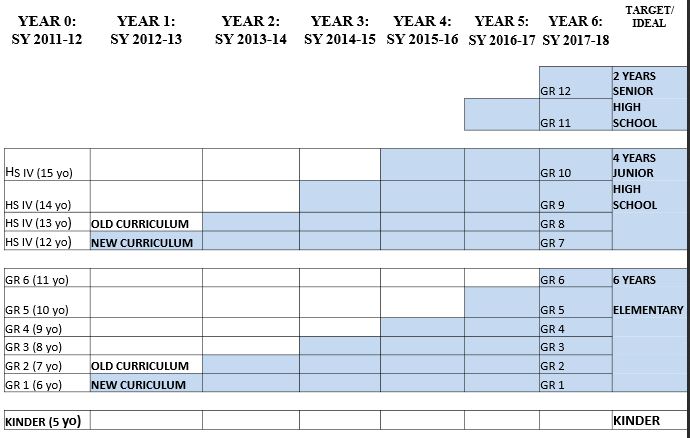Since the enactment of the Enhanced Basic Education Act of 2013, the government has started the implementation of the K to 12 program. However, now that it is being rolled out to schools, critics are calling for its
But what really is the K to 12 program (aside from the fact that there will be 2 additional years to the basic education of children)? Here are 12 things that you should know about it.
1. The Philippines is the last country in Asia to implement K-12
There are only 3 countries in the world that has a 10-year basic education (pre-college) program: Angola, Djibouti and Philippines. In Asia, we are the last country to implement K to 12.
2. K to 12 is free to public schools.
That’s what the government is trying to do. Of course there are indirect and miscellaneous costs to parents and schools but government agencies are collaborating to enable everyone free access to quality education, especially to those who belong to lower income brackets.

Critics however, are not keen to the extra years of schooling. They say that it will just be an additional burden to parents and the government is not ready to accommodate the students for the additional years due to lack of preparation, implementation, planning and funding.
3. The K in K to 12 is mandatory.
In the previous school system, the Kindergarten level is not required for a student to enter elementary. But in Republic Act no. 10157 or the Kindergarten Education Act, Kindergarten became a prerequisite for students to be admitted to Grade 1. In total, the number of basic education years for a student is 13 (a “lucky” number, perhaps?).
4. Mother tongue will be used as the medium of instruction in the first few grade levels.
In Kinder, mother tongue or lingua franca, shall be used as the medium of instruction. The language used in the locality, may it be Ilokano, Tagalog, Bisaya, Bicolano, etc., will serve as the medium in teaching the topics and concepts.
In Grades 1-3, the mother tongue will be used in teaching all subjects, except in teaching Filipino and English subjects.
Beginning Grade 4, the languages for instruction will be Filipino and English.
5. K to 12 has 13 years of schooling.
As mentioned in the previous item, there is a total of 13 year levels in the K to 12 program. These are:
6. K to 12 was rolled out “gradually” by DepEd.
Here’s how DepEd is rolling out K to 12.

Kindergarten implementation began SY 2011-2012
The enhanced curriculum for Grade 1 and Grade 7 (also known as 1st Year Junior High School) was rolled out in SY 2012–2013.
Grade 11 will be introduced in SY 2016–2017 and Grade 12 in SY 2017–2018.
If there was full implementation of K to 12, the first batch of K-12 students will graduate in March 2018. Thus there will be no college freshmen for SY 2016-2017 and SY 2017-2018.
However, there are private schools that implemented “relabeling” of their students and they will have graduates for the two mentioned school years (Get our free report about this here).
7. Not all schools will offer Grades 11 and 12.
Contrary to what most people know, not all schools will offer Grades 11 and 12 (Senior High). Some schools will not offer them not because they don’t want to, but because they can’t.
Thus, if a school (public or private) does not offer Senior high, the student needs to look for another school that offers Senior high.
8. K to 12 graduates are ready to be employed – even without a college degree.
Education Secretary Armin Luistro said that “the K to 12 program would like to ensure that even if they don’t choose to go to college, they finish studying what is basic.” K to 12 graduates may already be employed in several industries. This is because the curriculum enables students to acquire Certificates of Competency (COCs) and National Certifications (NCs).
9. Students will choose career tracks in the latter part of high school.
Unlike the existing curriculum wherein students are taking the same subjects, in the Senior High level, students can choose different specializations, called “tracks”.There are several major tracks that the student can choose from:
Students will undergo several assessments to determine their interests and strengths. These will include an aptitude test, a career assessment test, and an occupational inventory for high schools. With these components, students are properly guided in their decision on what specialization they want to take.
10. DepEd will partner with colleges and universities for K to 12.
Starting SY 2016-2017, DepEd will partner with colleges, universities and technical-vocational institutions to use their facilities and teaching staff for the Senior High implementation. This is to offset the reduction in enrollment in these institutions as well as to offset the lack of teachers and facilities in existing high school.
In fact, several colleges have already offered Grade 11 this school year as a test run for the K to 12 program. They will have Grade 12 graduates one year ahead of the K-12 full implementation.
11. The government is actively involved in K to 12.
A Joint Oversight Committee from the Senate and the House of Representatives shall be formed to oversee, monitor, and evaluate implementation.


Comments 3
Pingback: Roller Coaster Ride: Finale – Learn and Earn
Pingback: Lawmakers Back Review of K-12, But Rejects Calls to Abolish the Educational System - Buhay Teacher
Pingback: Are Grade 10 Students Allowed to Take the UPCAT? Here's the Answer.